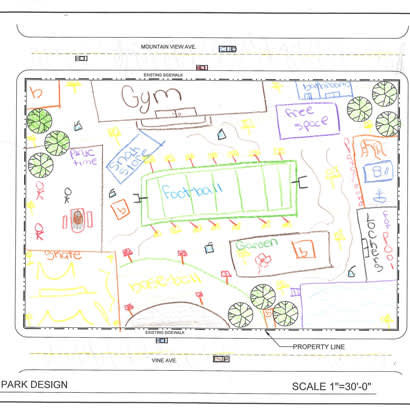
In planning and designing new facilities, park and recreation agencies typically seek public input through a meeting or a series of meetings. Having hosted and participated in many such meetings as a park planner, I believe they may not be the most effective way to obtain input that reflects all segments of communities and their diverse viewpoints. Children (under 18 years of age), for example, are often underrepresented or not represented at all. This is certainly alarming but not entirely surprising, considering that the formal or rigid nature of most public meetings can intimidate and discourage kids of all ages from openly sharing their ideas and thoughts.
Given that children are key park users and parks contribute significantly to their development and quality of life, we must be intentional and creative in how we engage them in the planning and design of parks. An important lesson I have learned over the years is that children have much to say about parks and have valuable insights to contribute. The challenge then is for us to engage them in ways that encourage and empower them to share their ideas and to actively participate in existing and future planning and design processes.
Voting for Park Features and Activities
Many kids today are tech savvy and most have their own smartphones. One way to effectively engage them is to have an activity during a community meeting that allows them to vote for their favorite park features (like a basketball court) and recreational activities (like skateboarding). This may be done using special mobile devices or smartphones, with participants being shown images of various park features and activities, and then being able to select the ones that appeal to them the most.
This approach was part of the process used to develop the Puente Hills Landfill Park Master Plan, which involves the conversion of the nation’s second-largest landfill into a regional park. Voting using sticker dots was also done on a large scale for the Los Angeles Countywide Parks and Recreation Needs Assessment as children and adults voted for their top 10 park projects in communities across the county. Although this method might be more old school, it was still a good way to determine a community’s park priorities.
Drawing and Building Dream Parks
The traditional public meeting tends to be dominated by a few loud voices, eager to share their opinions with everyone. To truly engage kids, meetings need to be more fun and interactive. Providing art supplies and allowing younger children to draw their favorite dream or ideal park is one way to do this. This type of activity not only encourages them to be creative and share their ideas visually, but it also helps parents to more freely participate in the meeting without having to worry about their children. For the Master Plan for Sustainable Parks and Recreation planning process, time was set aside toward the end of meetings for children to present their drawings. This helped to create an overall hopeful and positive feeling for all participants. Yet another way to engage kids is to provide them with toy blocks and other random materials they can use to build model parks. For example, planner and artist James Rojas’ interactive planning approach through the use of model building has proven successful in engaging the public, especially kids, and encouraging innovative city-making. Having had first-hand experience in a
Rojas-led exercise, I know this approach empowers participants by allowing them to shape and share visions in a supportive environment without the fear of providing a wrong answer.
Touring Parks
Sociologist Frederik Polak once said, “The future may well be decided by the images of the future with the greatest power to capture our imaginations and draw us to them, becoming self-fulfilling prophecies.” To enable children to see what is possible, they need to be exposed to a wide variety of park and recreation destinations. This is especially true for kids growing up in underserved communities with very few parks and lacking the means to travel to places outside of their immediate neighborhoods. As part of our various planning efforts, we organized tours for children to visit and experience parks in other areas. For example, during the Belvedere Skate Park’s design process, our department took young East Los Angeles skateboarders on a tour of various skateparks to see which design features they would like at their own skatepark. Also, for the Puente Hills Landfill Park Master Plan, many youths participated in an organized hike to the top of the landfill so they could experience what it would be like to have a regional park there in the future.
Visiting Schools
In addition to hosting meetings with activities that engage children and offering tours of parks, it is also important to visit children where they are and where they spend most of their time — at their schools. This requires coordination with and the cooperation of local school districts and/or principals, but it is well worth the effort. As part of the Florence-Firestone Community Parks and Recreation Plan, a middle school allowed us time to conduct a survey of its students to better understand their needs and preferences with respect to park and recreation programs. We also asked the students to illustrate their ideal park and came away with some wonderful pieces of art that were incorporated into the plan.
To meet the growing and diverse needs of communities, park and recreation agencies must effectively reach out to and collaborate with existing and future park users in the planning and design of recreational facilities. We must plan and design parks with, rather than for, children.
Clement Lau, AICP, DPPD, is a Departmental Facilities Planner with the Los Angeles County Department of Parks and Recreation, and a member of NRPA’s Health and Wellness Advisory Panel


